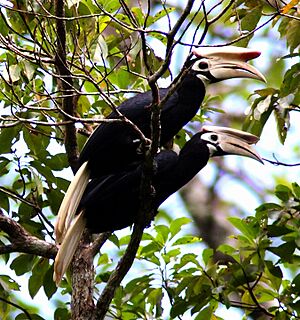Palawan hornbill facts for kids
Quick facts for kids Palawan hornbill |
|
|---|---|
 |
|
| Conservation status | |
| Scientific classification | |
| Genus: |
Anthracoceros
|
| Species: |
marchei
|
 |
|
| Palawan hornbill range | |
The Palawan hornbill (scientific name: Anthracoceros marchei) is a big, beautiful bird. It lives only in the forests of the Philippines. This special bird is one of 11 types of hornbills found only in that country. You can find it on Palawan island and a few nearby islands. These include Balabac, Busuanga, Calauit, Culion, and Coron. Local people call it 'talusi' in the Cuyunon language. Sadly, this bird is in danger. Its home is disappearing, and some people hunt it or try to catch it for pets.
Contents
What Does the Palawan Hornbill Look Like?
The Palawan hornbill is a large bird. It is about 70 centimetres (28 in) long. That's almost as tall as a 7-year-old kid! It weighs about 750 grams (26 oz). This is more than 92% of other bird species.
Its body is mostly black. It has a bright white tail. Its long, thick beak and the casque on top are a pale cream color. A casque is a helmet-like growth on the bird's head. The skin around its eyes and throat is whitish. This skin often has a blue tint.
Differences Between Males and Females
Male and female Palawan hornbills look a bit different. This is called sexual dimorphism. Males have bigger beaks and casques. They are also generally larger than females.
The Palawan hornbill is the only hornbill in its area. This makes it easy to spot! Its loud call sounds like "kaaww" and "kreik-kreik."
How is it Related to Other Hornbills?
Among hornbills in the Philippines, the Palawan hornbill is most like the Sulu hornbill. But you can tell them apart. The Palawan hornbill has a white beak and face. The Sulu hornbill has all black features.
What Do Palawan Hornbills Eat?
Palawan hornbills mostly eat fruit. They also sometimes eat insects and small animals. Because they are big and travel far, they help spread seeds. They are very important for large trees.
Many animals on the ground eat fallen seeds. If hornbills are not around, these animals eat too many seeds. This can stop new trees from growing. So, hornbills help keep the forest healthy.
How Do They Live?
You usually see these birds in pairs. Sometimes, they are in small, noisy family groups. They often gather in one place to sleep at night. You can often spot them eating fruit at the edge of the forest. They also hunt for insects and small reptiles.
Where Do Palawan Hornbills Live?
Palawan hornbills live in different kinds of forests. They like old-growth forests and newer forests. They also live in mangrove swamps. These are forests that grow in salty water. They can be found up to 900 meters high. Sometimes, they even visit farms.
These birds need large trees to build their nests. They do best in old-growth forests. This is where they have the most babies and are healthiest.
Why are Palawan Hornbills in Danger?
The Palawan hornbill is a vulnerable species. This means it is at risk of disappearing. Experts think there are only about 2,500 to 9,999 adult birds left. Their numbers have dropped by at least 20% in the last 10 years.
Threats to the Palawan Hornbill
The main reasons they are in danger are:
- Habitat loss: Their forest homes are being cut down. This happens for logging, farming, building cities, and mining.
- Hunting: Some people hunt them for food.
- Live bird trade: Some people catch them to sell as pets.
The Palawan hornbill is like a "bio-indicator." This means it shows how healthy the environment is. If these birds are struggling, it means the forest is also struggling.
How Are We Helping Palawan Hornbills?
The entire island of Palawan is a special protected area. It is called a biosphere reserve. But it is hard to stop all logging and hunting.
Many Palawan hornbills live in protected places. These include Puerto Princesa Subterranean River National Park and El Nido Marine Reserve. The bird is also listed in CITES Appendix II. This means it is protected from too much international trade.
What Can Be Done to Help?
People are working to help these birds. Here are some ideas:
- Find more birds: Look for hornbills in forests where they might still live.
- Stop illegal trade: Control the trade of birds caught for pets.
- Learn more: Study what the birds need to survive.
- Protect nests: Help protect their nests from harm.
- Expand parks: Make protected areas like Puerto Princesa Subterranean River National Park even bigger.
- Raise awareness: Teach people why these birds are important.
- Control hunting: Work harder to stop illegal hunting in Palawan forests.


